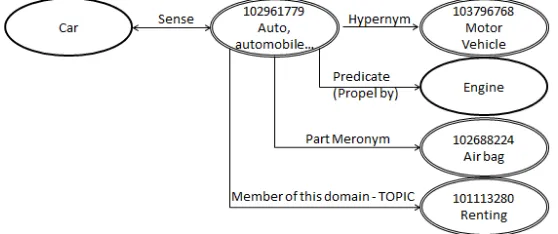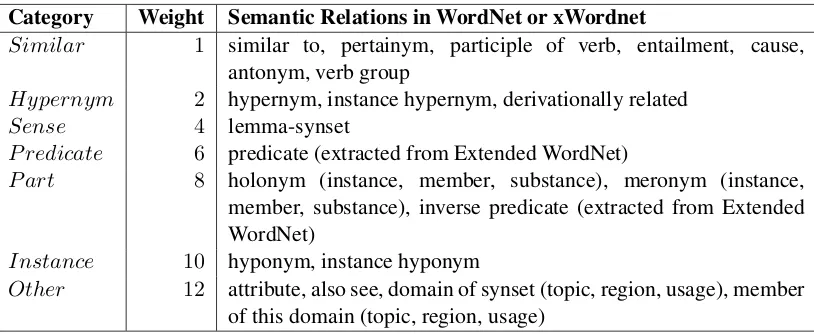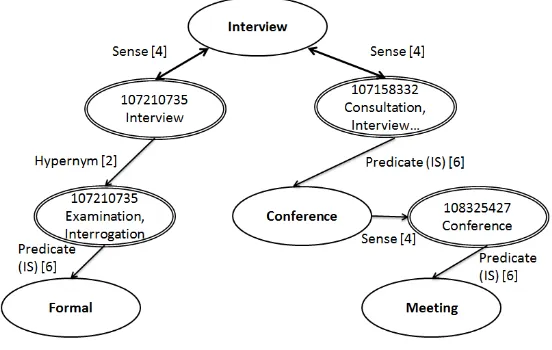ClaC: Semantic Relatedness of Words and Phrases
Reda Siblini
Concordia University 1400 de Maisonneuve Blvd. West Montreal, Quebec, Canada, H3G 1M8
r_sibl@encs.concordia.ca
Leila Kosseim
Concordia University 1400 de Maisonneuve Blvd. West Montreal, Quebec, Canada, H3G 1M8
kosseim@encs.concordia.ca
Abstract
The measurement of phrasal semantic relat-edness is an important metric for many nat-ural language processing applications. In this paper, we present three approaches for mea-suring phrasal semantics, one based on a se-mantic network model, another on a distribu-tional similarity model, and a hybrid between the two. Our hybrid approach achieved an F-measure of 77.4% on the task of evaluating the semantic similarity of words and compo-sitional phrases.
1 Introduction
Phrasal semantic relatedness is a measurement of how multiword expressions are related in meaning. Many natural language processing applications such as textual entailment, question answering, or information retrieval require a robust measurement of phrasal semantic relatedness. Current approaches to address this problem can be categorized into three main categories: those that rely on a knowledge base and its structure, those that use the distribu-tional hypothesis on a large corpus, and hybrid approaches. In this paper, we propose supervised approaches for comparing phrasal semantics that are based on a semantic network model, a distributional similarity model, and a hybrid between the two. Those approaches have been evaluated on the task of semantic similarity of words and compositional phrases and on the task of evaluating the composi-tionality of phrases in context.
2 Semantic Similarity of Words and Compositional Phrases
The semantic similarity of words and compositional phrases is the task of evaluating the similarity of a word and a short phrase of two or more words; for example, the wordInterviewand the phraseFormal Meeting. In the next section we present our seman-tic network model for computing phrasal semanseman-tic relatedness between a word and a phrase, followed by a distributional similarity model, that we evalu-ate on the task of semantic similarity of words and compositional phrases.
2.1 Semantic Network Model
Knowledge-based approaches to semantic related-ness use the features of the knowledge base to mea-sure the relatedness. One of most frequently used semantic network is the Princeton’s WordNet (Fell-baum, 1998) which groups words into synonyms sets (called synsets) and includes 26 semantic rela-tions between those synsets, including: hypernymy, hyponymy, meronymy, entailment . . .
To measure relatedness, most of those approaches rely on the structure of the semantic network, such as the semantic link path, depth (Leacock and Chodorow, 1998; Wu and Palmer, 1994), direction (Hirst and St-Onge, 1998), or type (Tsatsaronis et al., 2010). Our phrasal semantic relatedness ap-proach is inspired from those methods. However, our approach is based on the idea that the combi-nation of the least costly types of relations that re-late one concept to a set of concepts are a suitable indicator of their semantic relatedness. The type of relations considered includes not only the
Figure 1: Example of the semantic network around the wordcar.
ponym/hypernym relations but also all 26 available semantic relations found in WordNet in addition to relations extracted from each of the eXtended Word-Net (Harabagiu et al., 1999) synset’s logical form.
To implement our idea, we created a weighted and directed semantic network based on the relations of WordNet and eXtended WordNet. We used Word-Net’s words and synsets as the nodes of the network. Each word is connected by an edge to its synsets, and each synset is in turn connected to other synsets based on the semantic relations included in Word-Net. In addition each synset is connected by a la-beled edge to the predicate arguments that are ex-tracted from the eXtended WordNet synset’s logical form. Every synset in the eXtended WordNet is re-lated to a logical form, which contains a set of pred-icate relations that relates the synset to set of words. Each predicate in this representation is added as an edge to the graph connecting the synset to a word. For example, Figure 1 shows part of the semantic network created around the wordcar. In this graph, single-line ovals represent words, while double-line ovals represent synsets.
To compute the semantic relatedness between nodes in the semantic network, it is necessary to take into consideration the semantic relation involved be-tween two nodes. Indeed, WordNet’s 26 semantic relations are not equally distributed nor do they con-tribute equally to the semantic relatedness between concept. In order to indicate the contribution of each relation, we have classified them into seven cate-gories: Similar, Hypernym, Sense,Predicate, Part, Instance, and Other. By classifying WordNet’s re-lations into these classes, we are able to weight
the contribution of a relation based on the class it belongs to, as opposed to assigning a contributory weight to each relations. The weights were assigned by manually comparing the semantic features of a set of concepts that are related by a specific seman-tic relations. Table 1 shows the seven semanseman-tic cat-egories that we defined, their corresponding weight, and the relations they include. For example the cat-egory Similar includes WordNet’s relations of en-tailment,cause,verb group,similar to,participle of verb, antonym, and pertainym. This class of rela-tions has the most common semantic features when comparing two concepts related with any of those relations and hence was assigned the lowest weight1 of 1. All the 26 relations in the table are the ones found in WordNet, for the exception of the predicate (and inverse predicate) relations which are the predi-cate relations extracted from the eXtended WordNet. This can be seen in Figure 1, for example, where the wordcaris related to the wordEnginewith the Pred-icaterelation extracted from the eXtended WordNet logical form and more specifically the predicate pro-pel by.
The computation of semantic relatedness be-tween a word and a compositional phrase is then the combination of weights of the shortest weighted path2 in the weighted semantic network between that word and every word in that phrase, normalized by the maximum path cost.
1The weight can be seen as the cost of traversing an edge;
hence a lower weight is assigned to a highly contributory rela-tion.
2
Category Weight Semantic Relations in WordNet or xWordnet
Similar 1 similar to, pertainym, participle of verb, entailment, cause,
antonym, verb group
Hypernym 2 hypernym, instance hypernym, derivationally related
Sense 4 lemma-synset
P redicate 6 predicate (extracted from Extended WordNet)
P art 8 holonym (instance, member, substance), meronym (instance,
member, substance), inverse predicate (extracted from Extended WordNet)
Instance 10 hyponym, instance hyponym
Other 12 attribute, also see, domain of synset (topic, region, usage), member
[image:3.612.103.510.53.220.2]of this domain (topic, region, usage)
Table 1: Relations Categories and Corresponding Weights.
Figure 2 shows an extract of the network involv-ing the wordsInterviewand the phraseFormal Meet-ing. For the shortest path fromInterviewtoFormal, the word Interviewis connected with aSense rela-tion to the synset #107210735 [Interview]. As in-dicated in Table 1, the weight of this relation is de-fined as 4, This synset is connected to the synset Ex-aminationthrough aHypernymrelation type with a weight of 2, which is connected to the wordFormal with a predicate (IS) relation of weight 6. Overall, the sum of the shortest path fromInterviewto For-mal Meetingis hence equal to the sum of the edges shown in Figure 1 (4+2+6+4+6+4+6 = 32). By nor-malizing the sum to the maximum, In our approach, 24 is maximum path cost after which we assume that two words are not related (which we assume to be traversing two times maximum weighted path, 2 * maximum path weight of 12) and 8 is the mini-mum number of edges between 2 words (which is equal to traversing from the word to itself, 2 * sense weight of 4)). Taking into consideration the number of words in the phrase, the semantic relatedness will be (24*2 - (32-8*2))/24*2 = 66.7%. In the next sec-tion, we will introduce our distributional similarity model.
2.2 Distributional Similarity Model
Distributional similarity models rely on the distribu-tional hypothesis (Harris, 1954) to represent a word by its context in order to compare word semantics. There are various approach for the selection,
2.3 Evaluation
We evaluated our approaches for word-phrase se-mantic relatedness on the SemEval task of evalu-ating phrasal semantics, and more specifically on the sub-task of evaluating the semantic similarity between words and phrases. The task provided an English dataset of 15,628 word-phrases, 60% an-notated for training and 40% for testing, with the goal of classifying each word-phrase as either pos-itive or negative. To transform the semantic relat-edness measure to a semantic similarity classifica-tion one, we first calculated the semantic relatedness of each word-phrase in the training set, and used JRip, WEKA’s (Witten et al., 1999) implementation of Cohen’s RIPPER rule learning algorithm (Cohen and Singer, 1999), in order to learn a set of rules that can differentiate between a positive semantic simi-larity and a negative one. The classifier resulted in rules for the semantic network model based related-ness that could be summarized as follows: If the se-mantic relatedness of the word-phrase is over 61% then the similarity is positive, otherwise it is nega-tive. So for the exampleInterview-Formal meeting, which resulted in a semantic relatedness of 66.7% in the semantic network approach, it will be classified positively by the generated rule. This method was our first submitted test run to this task, which re-sulted in a recall of 63.79%, a precision of 91.01%, and an F-measure of 75.00% on the testing set.
For the second run, we trained the distributional similarity model using the same classifier. This re-sulted with the following rule that could be summa-rized as follows: If the semantic relatedness of the word-phrase is over 40% then the similarity is pos-itive, otherwise it is negative. It was obvious from the training set that the semantic network model was more accurate than the distributional similarity model, but the distributional model had more cover-age. So for our second submitted test run, we used the semantic network approach as the main result, but used the distributional model as a backup ap-proach if one of the words in the phrase was not available in WordNet, thus combining the precision and coverage of both approaches. This method re-sulted in a recall of 69.48%, a precision of 86.70%, and an F-measure of 77.14% on the testing set.
For the last run, we used the same classifier
but this time we training it using two features: the semantic network model relatedness measure (SN), and the distributional similarity model (DS). This training resulted in a set of rules that could be summarized as follows: if SN >61% then the similarity is positive, else if DS > 40% then the similarity is also positive, and lastly if SN> 53% and DS>31% then also in this case the similarity is positive, otherwise the similarity is negative. This was our third submitted test run, which resulted a recall of 70.66%, a precision of 85.55%, and an F-measure of 77.39% on the testing set.
3 Semantic Compositionality in Context
The semantic compositional in context is the task of evaluating if a phrase is used literally or figuratively in context. For example, the phrasebig picture is used literally in the sentenceClick here for a bigger pictureand figuratively inTo solve this problem, you have to look at the bigger picture.
Our approach for this task is a supervised ap-proached based on two main components: first, the availability of the phrases most frequent collocating expressions in a large corpus, and more specifically the top 1000 phrases by frequency in Web 1TB cor-pus (Brants and Franz, 2006). For example, for the phrasebig picture, we collect the top 1000 phrases that come before and after the phrase in a corpus, those includes look at the, see the, understand the ... If the context contain any of those phrase, then this component returns 1, indicating that the phrase is most probably used figuratively. The intuition is that, the use of phrases figuratively is more frequent than their use in a literal meaning, and hence the most frequent use will be collocated with phrases that indicate this use.
Figure 2: Shortest Path Between the WordInterviewand the PhraseFormal Meeting.
the old school, we can notice thathallwill be more related toold schoolthan the wordone. This compo-nent will result in two features: the relatedness to the word before the phrase (SRB) and the relatedness to word after the phrase in context (SRA).
To combine both componenets, we evaluated our approaches on the data set presented by the Se-mEval task of evaluating phrasal semantics, and more specifically on the sub task of evaluating se-mantic compositionality in context. The data set contains a total of 1114 training instances, and 518 test instances. We use the training data and com-puted the three features (Frequent Collocation (FC), Semantic Relatedness word Before (SRB), and Se-mantic Relatedness word After (SRA), and used JRip, WEKA’s (Witten et al., 1999) implementation of Cohen’s RIPPER rule learning algorithm (Cohen and Singer, 1999) to learn a set of rule that differen-tiate between a figurative and literal phrase use. This method resulted in a set of rules that can be summa-rized as follows:if FC is equal to 0 and SRB<75% then it is used literally in this context, else if FC is equal to 0 and SRA<75% then it is is also used lit-erally, otherwise it is used figuratively. This method resulted in an accuracy of 55.01% on the testing set.
4 Conclusion
In this paper we have presented state of the art word-phrase semantic relatedness approaches that are based on a semantic network model, a distribu-tional model, and a combination of the two. The
novelty of the semantic network model approach is the use of the sum of the shortest path between a word and a phrase from a weighted semantic net-work to calculate word-phrase semantic relatedness. We evaluated the approach on the SemEval task of evaluating phrasal semantics, once in a supervised standalone configuration, another with a backup dis-tributional similarity model, and last in a hybrid con-figuration with the distributional model. The hy-brid model achieved the highest f-measure in those three configuration of 77.4% on the task of evaluat-ing the semantic similarity of words and composi-tional phrases. We also evaluated this approach on the subtask of evaluating the semantic composition-ality in context with less success, and an accuracy of of 55.01%.
Acknowledgments
We would like to thank the reviewers for their sug-gestions and valuable comments.
References
Thorsten Brants and Alex Franz. 2006. Web 1t 5-gram version 1.
William W Cohen and Yoram Singer. 1999. A simple, fast, and effective rule learner. InProceedings of the National Conference on Artificial Intelligence, pages 335–342. John Wiley & Sons Ltd.
Christiane Fellbaum. 1998. WordNet: An Electronic Lexical Database. MIT Press.
Edward Grefenstette and Mehrnoosh Sadrzadeh. 2011. Experimental support for a categorical compositional distributional model of meaning. In Proceedings of the Conference on Empirical Methods in Natural Lan-guage Processing, pages 1394–1404. Association for Computational Linguistics.
Sanda Harabagiu, George Miller, and Dan Moldovan. 1999. Wordnet 2- a morphologically and semantically enhanced resource. In Proceedings of SIGLEX, vol-ume 99, pages 1–8.
Zellig S Harris. 1954. Distributional structure. Word. Graeme Hirst and David St-Onge. 1998. Lexical chains
as representations of context for the detection and cor-rection of malapropisms. WordNet An electronic lexi-cal database, pages 305–332, April.
Claudia Leacock and Martin Chodorow. 1998. Com-bining local context and wordnet similarity for word sense identification. WordNet: An electronic lexical database, 49(2):265–283.
Jeff Mitchell and Mirella Lapata. 2008. Vector-based models of semantic composition. proceedings of ACL-08: HLT, pages 236–244.
George Tsatsaronis, Iraklis Varlamis, and Michalis Vazir-giannis. 2010. Text relatedness based on a word thesaurus. Journal of Artificial Intelligence Research, 37(1):1–40.
Dominic Widdows. 2008. Semantic vector products: Some initial investigations. In To appear in Second AAAI Symposium on Quantum Interaction, volume 26, page 28th. Citeseer.
Ian H Witten, Eibe Frank, Leonard E Trigg, Mark A Hall, Geoffrey Holmes, and Sally Jo Cunningham. 1999. Weka: Practical machine learning tools and techniques with java implementations.


